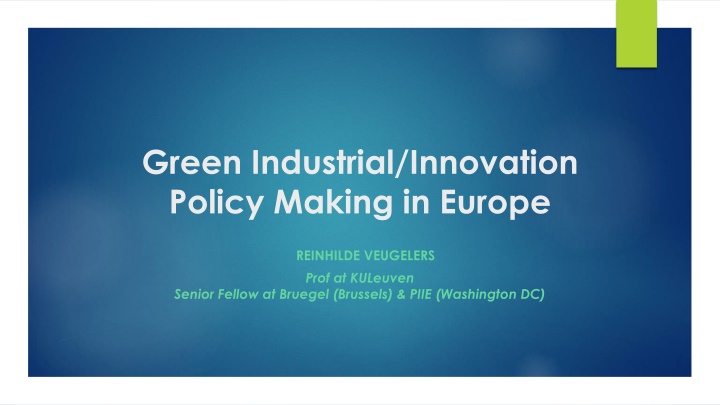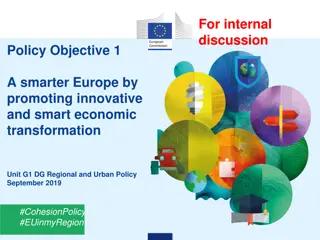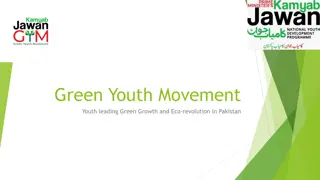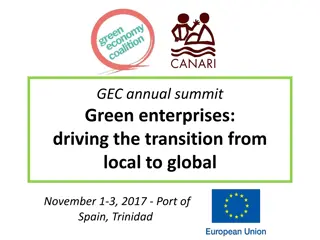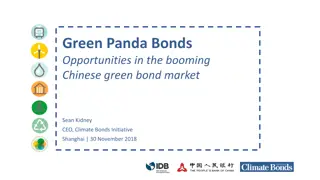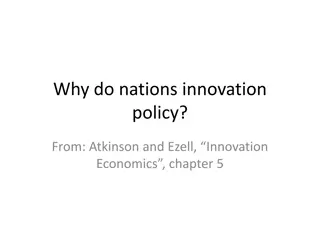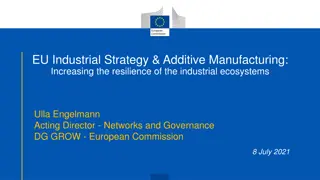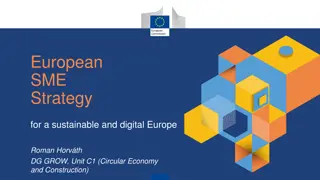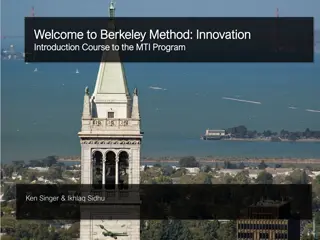Green Industrial Innovation Policy Making in Europe by Reinilde Veugelers
Shifting economies towards green industrial innovation in Europe is a significant transformation that requires reconciling various objectives like decarbonization, economic growth, job creation, and global competitiveness. The role of innovation in green industrial policy is crucial for delivering new technologies while ensuring resilience and strategic autonomy. Building resilience through innovation involves technology sovereignty and access to developed technologies. Making the innovation machine work for green industrial policy requires coordinating innovation and environmental policy instruments, avoiding transition failures, and addressing challenges in policy governance.
Download Presentation

Please find below an Image/Link to download the presentation.
The content on the website is provided AS IS for your information and personal use only. It may not be sold, licensed, or shared on other websites without obtaining consent from the author.If you encounter any issues during the download, it is possible that the publisher has removed the file from their server.
You are allowed to download the files provided on this website for personal or commercial use, subject to the condition that they are used lawfully. All files are the property of their respective owners.
The content on the website is provided AS IS for your information and personal use only. It may not be sold, licensed, or shared on other websites without obtaining consent from the author.
E N D
Presentation Transcript
Green Industrial/Innovation Policy Making in Europe REINHILDE VEUGELERS Prof at KULeuven Senior Fellow at Bruegel (Brussels) & PIIE (Washington DC)
Shifting economies from brown to green represents one of the major socio-economic transformations ever seen in history. Countries are still figuring out how to reconcile the multi-dimensional objectives of a green industrial policy, particularly when these dimensions counteract each other: HOW TO COMBINE DECARBONIZATION WITH ECONOMIC GROWTH AND JOBS AND WORLD COMPETITIVENESS, AND ALL THIS WITH RESILIENCE AND SOVEREIGNTY/AUTONOMY/SECURITY OF SUPPLY?
THE INNOVATION ANGLE IN GREEN INDUSTRIAL POLICY. We will need the innovation machine at full capacity to deliver improved and new technologies for the green transition. The innovation angle can reconcile decarbonization, competitive value creation and jobs, and strategic autonomy at global scale, provided the innovation machine is properly guided by policy.
The innovation machine for resilience/strategic autonomy Innovations can also play a vital role in building resilience, alleviating future bottlenecks for clean technology supply chains. E.g. Energy efficiency New designs that use less critical materials; Manufacturing techniques with less material waste; Reuse and recycling Materials substitution (eg new batteries materials) Development of modular production technologies that can easily switch between material needs The innovation machine for building resilience requires technology sovereignity Requires own innovation capacity and absorptive capacity Requires access to elsewhere developed/developing technologies;
Making the innovation machine working for green industrial policy Specifics of clean technologies for innovation policy making Mixing and Coordinating innovation policy instruments and environmental policy instruments Avoiding lock-ins and path dependencies, deblocking transition failures Hidden support to fossil fuels given in different forms More need for directionality Higher knowledge externalities & combination with environmental externalities & more path dependency Eg R. Martin et al (2019) illustrate higher knowledge spillovers (as measured by patent citations) for clean technologies Involvement of private and civil society Policy Governance challenges
Some principles for GIP from insights from new industrial policy 6 Strong operational governance to address coordination among different types of stakeholders, different policy governance areas Public private partnership, blended finance; willingness to co-finance from private sector to weed out rent-seeking Long-term commitment and accountability from parties involved through a balanced set of sticks and carrots Flexible policy design, addressing the information problem with learning from monitoring & evaluation; Allow for policy experimentation, but with clear monitoring & evaluation plan, such that unsuccessful experiments are stopped/restructured in time Deploy a mix of policy instruments; Beyond (co)financing, also instruments shaping the framework conditions for solutions to work and about solving information failure and coordination failure Combine selection with competition Combine selection with bottom-up Taking risk, not avoiding failure, by targeting particularly new to be developed eco-systems and markets, with stakeholders previously unconnected. Adapting dedicated processes and instruments to de-risk new projects (smart development banks, intermediate milestones )
EU public funding for green innovation >90% of the public funding for R&D in the EU runs through Member States. EU-DG COMP State Aid Control EU level funding programs for clean tech Its 2021-2027 Framework Programme, Horizon Europe, around EUR 15 billion is earmarked for climate, energy and mobility projects. The EU and its Member States deploy a mix of green innovation policy instruments, combining carbon pricing, targets, regulations with public support for R&D and early deployment, Trend towards PPPs encompassing all players operating in a value chain Science, early stage, low technology readiness levels Bottom up: ERC, EIT Yet, appears more as a collection of policy initiatives than as a truly coherent green industrial policy framework. Directed & PPPs at EU scale Alliances (Battery Alliance), IPCEI (Hydrogen), EIC, Missions Innovation Fund (from ETS) for demonstration Missing is a convincing strong policy governance.
EU reaction to IRA: NZIA, (CRM), TCTF, (STEP) Net Zero Industry Act (reaction to IRA) List of net-zero technologies considered to be strategic ; Close to market: TRL 8 Adoption of a 40% target for EU domestic clean tech manufacturing over deployment in 2030 MS select Net-Zero Strategic Projects (NZSPs) NZSPs to get priority status at national level, and fast- track in permitting procedures Sustainability and resilience criteria included in public procurement and auctions (15-30% award criteria weighting) + disadvantage bids using tech from country with >65% supply share No new EU-funding in NZIA, has to come from MS: Importance of State Aid Control: Temporary Crisis & Transition Framework Revision Allows to provide higher support to SMEs and companies in disadvantaged regions Allows to also cover OPEX, up to the identified funding gap Allows to do matchingaid in exceptional cases and respecting several safeguards
Concerns on EU NZIA concerns It adopts a top-down approach, cherry-picking NZIA technologies and strategic NZIA projects It exclusively focuses on the deployment of high TRL technologies It adopts a one-size-fits-all 40% target that is arbitrary A key focus is fast-tracking of permitting procedures: not sure how defining this really is for all technologies Strategic use of public procurement risks irrelevance, given 10% higher cost safeguard Governance is weak. how EC will implement and monitor? NZIA does not leverage the European scale and lacks a sufficiently strong EU-level funding strategy; risk of intra-EU subsidy race
How the EU should respond to IRA? Next steps for EU GIP Get innovation/industrial policy requires a big coordination effort, as well as strong monitoring and evaluation capacity to assess which policy interventions work and which not, learn fast and shift fast to adapt policy making. This requires a highly competent and empowered governance body, with strong political mandate. Leverage the Single market The single market is the EU s most important tool for providing incentives for private clean-tech investment. a strong governance to deliver. EU
How the EU should respond to IRA? Next steps for EU GIP Revamp EU subsidies for RDD Further develop an EU-level funding strategy for clean-tech to complement and leverage MS funding, STEP funding to support pan-European projects along the whole innovation cycle, with subsidies (e.g., grants, guarantees, loans) aimed at leveraging private investments. Ideas of action: EU ARPA-EC, Missions/Calls/Prizes for clean tech resilience Top-ups to national support for pan-EU projects: IPCEIs topped up Top-ups for joint pan-EU green innovative procurement Intra-EU mobility for cleantech skills (NZIA Erasmus, Marie Curie Mobility Schemes and dedicated Horizon actions).
How the EU should respond to IRA? Revamp directed green subsidies for RDD Develop a portfolio of directed green missions: allocation to projects with largest socio-economic and climate returns, focus on early stage technologies with potential for general-purpose breakthroughs but with high risk of market/network failures/funding gap; New support models that provide grants in a non-bureaucratic way with independence, yet clear targets and accountability: An ARPA-climate? DARPA is frequently heralded for its successes in funding mission-oriented high-risk, high-reward research. More than just importing the label; DARPA s key success elements (see Azoulay, Fuchs et al (2019): Size of budget (to allow multiple bets) DARPAble domains: mission-motivated research on nascent technologies within an inefficient innovation system. Missions must be clearly identifiable, associated with quantifiable goals and trackable progress metrics. (Eg. NOT basic research) Organizational flexibility and to ability recruit program directors flexibly. Autonomy given to program directors, combined with accountability and clear targets. Key is attracting program staff who are more like risk-taking, idea-driven entrepreneurs than administrators.
Tagliapietra, S., Veugelers, R (2023) (Eds), Sparking Europes New Industrial Revolution: A policy for net zero growth and resilience,Bruegel Blueprint. Kleimann, D., Poitiers, N., Sapir, A., Tagliapietra, S., V ron, N., Veugelers, R., & Zettelmeyer, J., 2023, Green tech race? The US Inflation Reduction Act and the EU Net Zero Industry Act. The World Economy Veugelers, R., S. Tagliapietra, C. Trasi, 2024, Green Industrial Policy In Europe: Past, Present and Prospects, Journal of Industry, Competition and Trade, forthcoming. Veugelers, R (2024) Powering the Clean Energy Innovation System, PIIE Working Paper 24-5. Reinhilde.veugelers@kuleuven.be https://www.bruegel.org/people/reinhilde-veugelers
